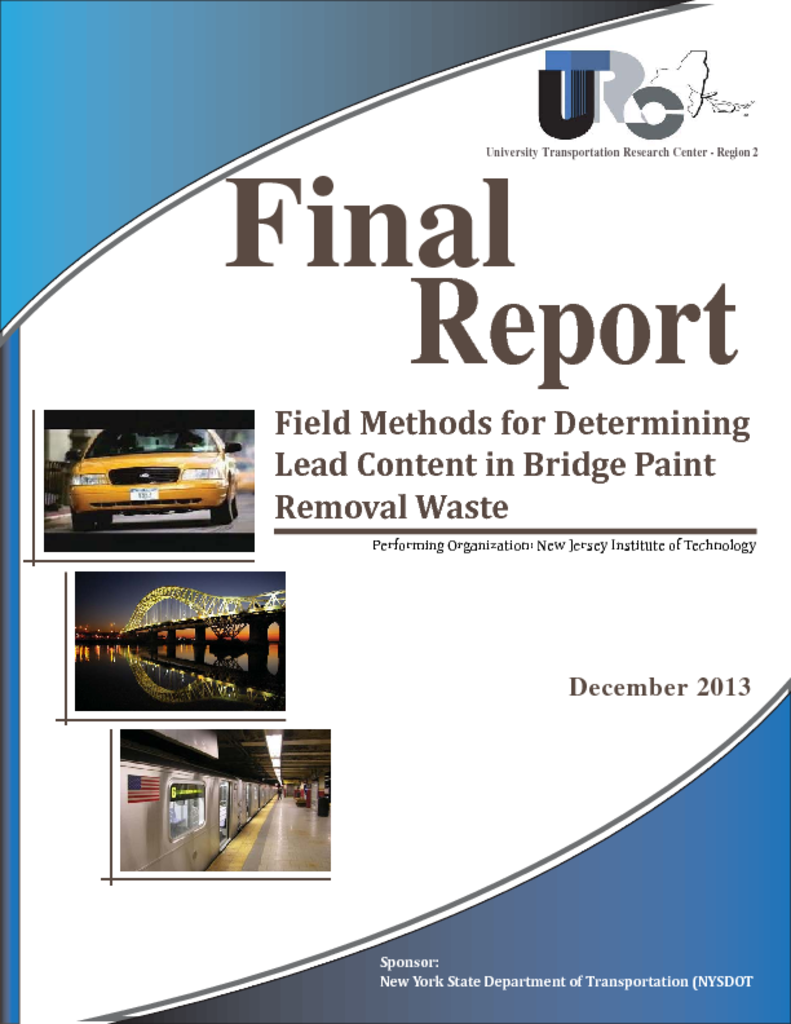The removal of paint from bridges and other structures is a significant issue facing transportation agencies because of the presence and potential for release of lead and other contaminants upon disposal. A large percentage of the bridges are reaching a critical level of deterioration, resulting in management issues for paint waste. The New York State Department of Transportation (NYSDOT) applies a conservative approach by assuming all waste generated from bridges previously painted with lead-based paint (LBP) is hazardous. Therefore, an approach that provides accurate in-situ characterization of the waste classification would be beneficial. The goal of this project is to develop a rapid and cost-effective method that can provide an accurate characterization of waste classification. With 11 Regions and 2,385 bridges rehabilitated and subsequently repainted after NYSDOT stopped using LBP on bridges (after1988), 24 bridges from across the NYS were selected for this study based on Sampling Theory (Deliverable Task 1). The literature review demonstrated that elevated metal concentrations in paint waste have resulted in leaching that exceeds toxicity characteristic (TC) concentrations; however, models to predict leaching behavior have not been developed (Deliverable Task 2). Field portable X-ray fluorescence (FP-XRF) (Deliverable Task 3) was applied to quantify Resource Conservation and Recovery Act (RCRA) metals (i.e., As, Ba, Cr, Cd, Pb, Hg, Se, and Ag) along with iron and zinc in paint waste samples (Deliverable Task 4), while Hach DR 2800 field portable spectrophotometer (Deliverable Task 3) was employed for measuring dissolved and total lead concentrations in bridge wash water (Deliverable Task 5). Leaching behavior of the paint waste was evaluated with the U.S. Environmental Protection Agency (U.S. EPA) toxicity characteristic leaching procedure (TCLP) and multiple extraction procedure (MEP) (Deliverable Task 6). Elevated Pb (5 to 168,090 mg kg-1), Cr (21 to 10,192 mg kg-1), and other metal concentrations were observed in the paint samples. However, 48 out of 51 samples passed the TCLP test, while 19 out of 24 samples revealed concentrations less than the TC level in the MEP study. These results are attributed to the use of iron-based abrasives (steel grit) in the paint removal process. Trace metals are sequestered through interactions with the steel grit surface resulting in reduced leachable concentrations (less than the TC limit). Using the suite of analyses including sequential extraction procedure (SEP), X-ray diffraction (XRD), and field emission scanning electron microscopy (FE-SEM), iron oxides were observed on the steel grit surface and are important surfaces affecting the degree of metal leaching from the paint waste (Deliverable Task 6). Given an understanding of mechanistic processes along with a demonstrated analysis of variables through principle component analysis (PCA), statistically-based models for leaching from paint waste were developed (Deliverable Task 7). The statistical models demonstrated 96 percent of the data fall within the 95% confidence level for Pb (R2 0.6 – 0.9, p ≤ 0.01), Ba (R2 0.6 – 0.7, p ≤ 0.1), and Zn (R2 0.6 – 0.7, p ≤ 0.01), although the regression model was not significant for Cr leaching (R2 0.5 – 0.7, p ≤ 0.75). The models have applicability over a wide range of total metal concentrations. A practical advantage in applying models developed is the ability to estimate contaminant leaching from paint waste without additional laboratory studies including the U.S. EPA TCLP. Therefore, the statistically-based models developed are a powerful approach for predicting metal leaching and therefore waste classification.


